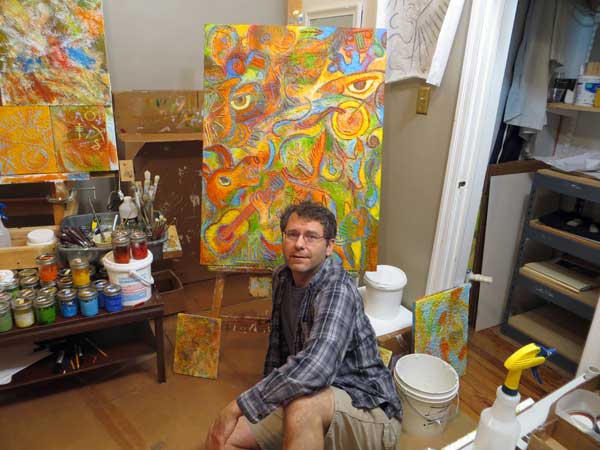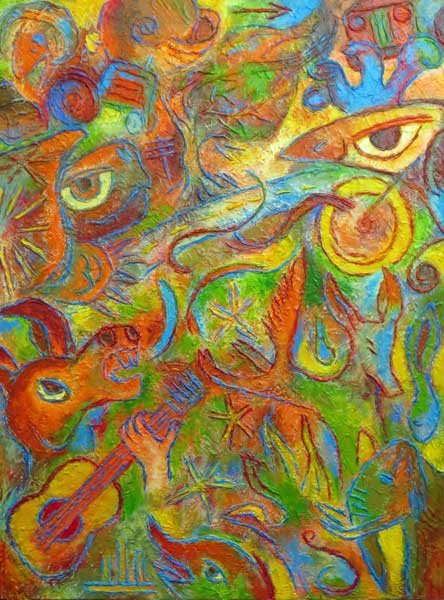Don’t Rush The Design Process
It is easier for me to explain what I mean about pace and long term experiments if I discuss my painting instead of my mosaic artwork. Compared to most mediums of visual art, mosaic isn’t typically executed in a rush because the amount of work usually requires multiple sessions in the studio. (You don’t slap on some tile quite as quickly as you do paint.) However, the point I make about my painting has a lot of relevance to the process of DESIGNING or CONCEIVING a mosaic composition and how you reflect on the work in progress and evaluate color decisions as you go along. Never blindly execute what you initially guessed to be a good decision. The design “mode” should never be turned off if your are trying to make great art.

Artificial Deadlines Are A Double-Edged Sword
Accomplishment builds confidence, but what are you accomplishing if you aren’t happy with the results?
Not long after starting Mosaic Art Supply, I found myself working on painting more than mosaic, at least in the studio time that I set aside for my own projects. (Go figure.) I made the decision to work on my painting in the following way: I would complete a small painting in a single session each night and then write something about creating it (personal significance or techniques) and then publish the painting’s photograph and text online. I didn’t use a blog format, but it was essentially a blog, with pages named for the artwork in question and no dating. Most of my paintings at Riverson Fine Art were created in this way.
This one-painting-each-night approach was great for getting me accustomed to “finishing” work, but the constant artificial deadline of having to be done that night also made me hectically overwork some paintings (because I didn’t spend enough time looking at what I was painting and felt a rush to go with snap decisions). I also didn’t allow enough time to figure out technical questions before the lack of knowledge showed on the canvas in a clear way.
It became clear that this exercise of doing rapid experiments each night could only teach me so much, and it had clearly taught me some bad habits that I had to unlearn somehow.
Kids Don’t Try This At Home
My solution was to totally change the pace of how I created art and not worry about publishing it or showing it. (The mosaic business was giving me more of a public presence than I wanted anyway.) But I did much more than this: I went to the opposite extreme. I didn’t even think about individual compositions or at least completing them as compositions. I drew up long lists of technical questions I needed to answer (such as how to mix up any color, ANY color I might need, shade or hue), and then I laid out what experiments I needed to do to find the answers.
More than that, I allowed myself to digress into a series of smaller investigations if I got stumped on a particular color or problem, no matter how irrelevant the issue seemed by itself. It was merely enough that I couldn’t answer the question, and I worked until I figured it out. I wanted to know how to do whatever it was in the event the same issue ever came up later when I started painting figurative compositions again.
This might seem obsessive on the surface, but I had already painted enough canvasses in a completely unsatisfactory way to know that I wouldn’t have the confidence to complete anything until I was more technically competent.
In the case of how to mix up any shade or hue, I simply painted a series of mixing grids, such as recommended and discussed in most books about how to paint.
To get the type of effects I wanted, I also needed to know how these colors looked when imperfectly layered over a canvas textured with peaks of modeling paste so that the layer underneath showed in the valleys. This greatly multiplied the number of variables I had to figure out.
How would these look when color complements were paired? What about warm on warm or cool on cool? How would they look with dark on light or vice versa? How did making the upper layer more translucent with medium affect the hue of the layer underneath? How did varying the size and type of texture affect ALL of the above?
Should the texture be rounded or sharp? Should texture run in raised ridges at the edges of figures? What would be the most effective way of duplicating specific results I found pleasing? How controlled or random should the sequence of layering be?
And then there was my META question: If I mastered all of these variables, could I use the resulting techniques to make quick-drying acrylic paint look as visually interesting and complex as slow-drying oil paint, which naturally diffused creating soft edges and subtle transitions of hue?
The answer could only be found by executing all of these combinations in a lengthy series of large abstract canvasses that took literally years. Each canvas was painted 10, 20 times, maybe 50 or more. Not 50 layers of paint. I mean 50 uses of the canvas for different “compositions” of multiple layers with all the accumulating texture that provided. Some of my canvasses from this period are almost as heavy as mosaics.
Finally, just 6 months ago, I felt that I had investigated enough unknowns to have a vocabulary of techniques sufficient to attempt a figurative composition again with confidence. So I started painting figurative works again, or rather, I started trying to paint figurative compositions again, and I felt anything but confident.
For starters, it wasn’t that easy to stop digressing each time I had a question about hue, texture or other variables in combination. I had gotten in the mode of “find out how” not “wing it to complete the composition.”
Also, I had to factor in how I developed compositions. I don’t work from a model in front of me. I work from hundreds of remembered models arranged in imaginative compositions. I draw from the imagination. I also work interactively with the canvas to allow figures to evolve from seemingly random strokes. I like to let the design emerge from the canvas in a way similar to how the mind sees objects in clouds, which I think is one of the highest forms of visual art.
All of this is fairly absorbing and cannot be done if I am having to concentrate too much on how to get the effects I want.
The long and the short of it is that I finally have a painting near enough completion to show after years of one long extended series of experiments that took over 4 years.

Parallels with Mosaic Art
In a mosaic, you may not have layering of color as a variable, but you definitely have juxtaposition of color, and you have variegation of color fields and color field transition. You also have how all of these variables are affected by tile size and work lines (andamento: how the tiles are arranged in contours to show motion or arranged randomly or grid-like). Think about all these variables and how they might be used to make your composition stronger. Of course, you don’t have to go completely mental like I did with painting and try to think about every combination of variables, but do spend some time thinking about what else might be before you begin setting tile in concrete.
A Practical Way To Experiment In Mosaic
Draw a cartoon (outline) of your design on the mosaic backer with a pencil, and then just place tile in the different color fields. At first, think about just different pairs of complementary colors, and try to get the basic color layout planned. Then think about how each color field might be made more visually complex by adding a few related hues or shades to the color field instead of using only one hue or shade. Once that is fairly worked out, then think about what size the tiles should be and how they should be arranged. It is hard to go wrong by arranging tiles in lines parallel to the outlines of figures. These contoured work line suggest motion, and this almost always looks more interesting than random patterns or grids. Remember, you aren’t tiling a shower or bricking a wall. You are rendering an image, so take advantage of all the trompe l’oeil you can, especially andamento!
The meta message is this: You can’t tile over an unsuccessful part of a mosaic the same way you can quickly paint over an unsuccessful part of a painting. This means that designs are enhanced when you do quick experiments with your cartoon BEFORE you start mounting tile: merely lay the tile out loosely on your outline and see how the colors work together. Try different combinations. You can’t try them after the tile is glued down, or at least as easily. Make haste slowly and avoid the need to chisel off glass tile.

Leave a Reply